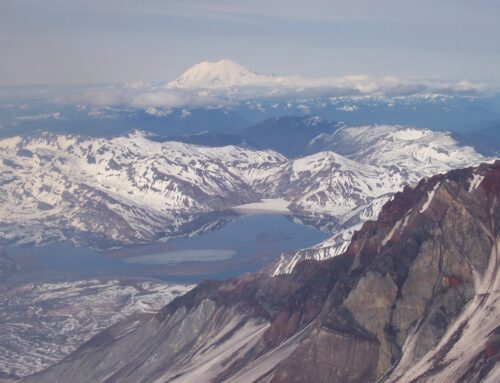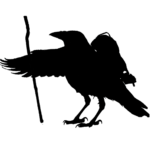My goal was a nameless peak on the western edge of the Cascades. Almost exactly four thousand feet in elevation, with a small summit formation and a jumble of talus sloughing down its southeastern slope, the peak’s anonymity was understandable. Looking south from the tiny summit, I could quickly identify nine other small mountains; all named, many accessible by trails, and a few popularized by area guidebooks. The banality of my destination was unavoidable, and it was exactly what I had hoped for.

Parking at the eastern terminus of the S2000 road, between the Siouxon and North Siouxon creek valleys, I made short work of a chilly, thirty-minute uphill hike along the 126 trail towards Huffman Peak. Stepping off the footpath a bit before the intersection with the 129 trail, I was pleased to find the slope of the peak’s western spur as gentle as the map promised, allowing a short, pleasant climb up through the timber. Thankfully my timing was accurate, and I reached my goal an hour before sunset. I had ample time to establish a quick camp, and chose a viewpoint for the moonrise at nine that night.
 Picking my way around fallen trees on the way up, I was disappointed to find that a tussle of Noble Firs blocked the view Mt. St. Helens, Sugarloaf, and Mount Mitchell. Fortunately, a rock shelf protruded from the summit just enough to see the sequence of Huffman Peak, Siouxon Peak, and Mt. Adams, all waiting for the moon to rise along their common axis. A strong, cold, southeast breeze blew across the snow on the summit, forcing me to abandon my camera tripod and wait for sunset in a small leeward pocket. In time, Venus appeared in the sky, along with the lights of Clark County and Portland, as the sun sank behind Oregon’s Coast Range. A brief glint of sunset hit the waters of the Columbia River and Merwin Reservoir as the glow from Longview and Kelso faintly backlit Lakeview Peak.
Picking my way around fallen trees on the way up, I was disappointed to find that a tussle of Noble Firs blocked the view Mt. St. Helens, Sugarloaf, and Mount Mitchell. Fortunately, a rock shelf protruded from the summit just enough to see the sequence of Huffman Peak, Siouxon Peak, and Mt. Adams, all waiting for the moon to rise along their common axis. A strong, cold, southeast breeze blew across the snow on the summit, forcing me to abandon my camera tripod and wait for sunset in a small leeward pocket. In time, Venus appeared in the sky, along with the lights of Clark County and Portland, as the sun sank behind Oregon’s Coast Range. A brief glint of sunset hit the waters of the Columbia River and Merwin Reservoir as the glow from Longview and Kelso faintly backlit Lakeview Peak.
Three hours later, my time on the snowy summit came to a close. The nearly full moon had changed from a light yellow to full white, as it chased the sun’s path up and across the sky. Chilled to the point of lightly shaking, I gathered my things and began a planned retreat to the shelter of the treeline. Just before stepping off the summit rock, a prolonged wind halted me with a brief deja vu. I spontaneously smiled in the darkness at the wind’s reminder of my irrelevance in the context of larger forces. Within hours that light wind would kill me, if I choose to remain still and endure its pain. I had experienced that same visceral, wind-driven joy nearly ten years before, near a nighttime field in Woodland’s bottoms. As on the summit, that wind blew where it would, without respect for me, the town, or anything we humans had built. I have grown to find liberation in the realization of my irrelevance.

I hike because I am small. In sixty years no one will remember my name. That truth is evidenced in the vistas I find myself drawn to. On that nameless summit, I see the Goat Rocks sitting demurely in the distance beyond Huffman, almost unnoticed in their decayed state. Gilbert Peak, Ives Peak, and Old Snowy form the Goat Rocks. The Rocks are the last remains of a once-dominant stratovolcano. Today, these sibling summits retreat into the countless points and folds seen on the horizon. Looking to the southeast, I search for Indian Racetrack at the far end of a series of hilltops. I can identify the hills, but the ground where the first peoples gathered remains hidden. I imagine the generations of humans who spent a portion of their days, before the zenith of their race passed, thriving in a wilderness we Europeans now call Indian Heaven. I stand, briefly halted, as the wind moves the trees and saps my heat and I watch the moon rise a bit higher. The moon will rise and fall, the snow will come and go, the land will slowly shift, all oblivious to my experience of triumph or pain, achievement or injustice.
Below and far to my left, thousands of dull, yellow lights obediently illuminate the sky. In my mind, I dip down from the meta to the micro. Down in those valleys there are thermostats and cul-de-sacs, fiat currency and the idea of law. We have made a beautiful bubble for ourselves, where the security of individual control smothers our perspective. Such hard-won, necessary progress. So much we have achieved, since the beginning of the neolithic.

Inside my bubble of civilization, I am tempted to ponder my significance. Dropping my focus down to the level of property, professions, charity, and my network of human connections, I am tempted to measure an individual’s impact. In the micro-view, it is possible to sustain a couplet of individualism and comparison, clouding out the reality of the larger context.
Immersing in nature restores my context. Sitting on the blast-scoured ridges of the Mount Margaret Backcountry, or feeling the crushing cold of a wind gust, humbles me into accepting my lack of strength. Walking in the Siouxon, watching the ceaseless cycle of sun, moon, snow, melt, bloom, and decay calms me into accepting my lack of control. Observing grand vistas, and decayed rocks, highlights the vast scale of time and distance; reminding me of the irrelevance of my infinitesimal place in the world.

I sit on the summit again, now warmed by the fully-dawned sun. A flock of birds bursts past the summit, a collective bouncing cloud that speeds south, heedless of the three thousand feet between themselves and the Siouxon Valley floor. I gaze out at the scope of the Gifford Pinchot, and once again see the choice. Maintaining my individual perspective ultimately leads to nihilism, as I compare myself to an overwhelmingly larger world. That nihilism becomes an easy spiral down to a rationalization of self-interest. Alternatively, embracing a global perspective requires continually facing my irrelevance, but creates an appreciation of something bigger and a desire to contribute. The confrontation with this choice is what drives me into our Land. I cherish the experience of nature sans man precisely because it illuminates this difference in perspective. I seem to require a periodic reminder of the larger perspective, and my tiny place within it. That reminder produces a rejuvenation, an acceptance of my insignificance, and also a motivation to build, create, and help.

By mid-morning I am picking my way around windfall as I descend through the timber. I pause, as usual, as the trail hugs the base of an almost perfectly vertical wall of rock. The wall always seems out of place, emerging randomly within the uniform forests along the 126 trail. Ten minutes farther on, I make a sharp left and depart from the 126 as it follows the ridge down to North Siouxon Creek. The short cut-off quickly leads to an informal trail head, close to where my truck has been obediently waiting overnight. Pausing to appreciate the view of Mitchell and Sugarloafs’ snow-dusted summits, I glance back left and notice two fresh tire ruts that have torn the soil and vegetation for twenty feet up the ridge. No doubt the driver felt a pleasurable thrill of power as his vehicle conquered that portion of the land. Significance, power, and control are always available if you keep your perspective sufficiently small. I inhale repeated draughts of sweet, cold air as my boots crunch through a last patch of snow near my truck. I smile again, at my smallness, feeling grateful for all the places I have left to explore.








